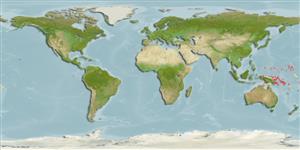>
Acanthuriformes (Surgeonfishes) >
Siganidae (Rabbitfishes)
Etymology: Siganus: Latin, siganus = a fish, rabbit fish; by the similarity of the nose (Ref. 45335).
Eponymy: Dr John ‘Jack’ Ernest Randall Jr. [...] (Ref. 128868), visit book page.
Environment: milieu / climate zone / depth range / distribution range
Ekologi
laut berasosiasi dengan karang; kisaran kedalaman 1 - 15 m (Ref. 37816). Tropical; 15°N - 15°S, 135°E - 159°W
Western Pacific: Solomon Islands, Papua New Guinea, Pohnpei, Kosrae, and Guam.
Size / Weight / umur
Maturity: Lm ? range ? - ? cm
Max length : 33.5 cm FL jantan/; (Ref. 107958); common length : 25.0 cm TL jantan/; (Ref. 9813); Berat maksimum terpublikasi: 824.00 g (Ref. 107958)
Duri punggung (Keseluruhan (total)) : 13; duri punggung lunak (Keseluruhan (total)) : 10; Duri dubur: 7; Sirip dubur lunak: 9; vertebrata, bertulang belakang: 23. Body is bronze, with bluish spots on the head and anterior portion of the body. These spots join in the posterior portion to form vermiculating patterns. Preopercular angle 98°-102°; strong scales covering cheeks with 9-11 rows deep below center of orbit; midline of thorax scaled, pelvic ridges without scales. Low rim of anterior nostril bearing a minute, pointed peak posteriorly. The spines are stout, blunt and venomous. S. randalli is similar to S. vermiculatus but is spotted on the head and front of the back (Ref. 37816).
Adults inhabit coral reef areas with sand and coral rubble, down to at least 15 m. Juveniles found in mangroves (Ref. 9710). Adults occur in schools of 10 to 20 or more and feed on algae growing on compacted pavement areas (Ref. 9813).
Life cycle and mating behavior
Kematangan | Reproduksi, perkembang biakan | Pemijahan | telur-telur | Fecundity | Larva
Woodland, D.J., 1990. Revision of the fish family Siganidae with descriptions of two new species and comments on distribution and biology. Indo-Pac. Fish. (19):136 p. (Ref. 1419)
Status IUCN Red List (Ref. 130435: Version 2024-2)
ancaman kepada manusia
Venomous
penggunaan manusia
Perikanan: perikanan swasembada; Budidaya air: percobaan
Alat, peralatan
laporan khas
muat turun XML
Sumber internet
Estimates based on models
Preferred temperature (Ref.
123201): 28.7 - 29.5, mean 29.1 °C (based on 328 cells).
Phylogenetic diversity index (Ref.
82804): PD
50 = 0.5000 [Uniqueness, from 0.5 = low to 2.0 = high].
Bayesian length-weight: a=0.01479 (0.00801 - 0.02733), b=3.05 (2.89 - 3.21), in cm total length, based on LWR estimates for this species & Genus-body shape (Ref.
93245).
Trophic level (Ref.
69278): 2.0 ±0.00 se; based on food items.
Daya lenting (Ref.
120179): Tinggi, Waktu penggandaan populasi minimum kurang dari 15 bulan (Preliminary K or Fecundity.).
Fishing Vulnerability (Ref.
59153): Low to moderate vulnerability (27 of 100).
Nutrients (Ref.
124155): Calcium = 38.2 [18.7, 89.5] mg/100g; Iron = 0.675 [0.317, 1.554] mg/100g; Protein = 18.5 [17.0, 20.0] %; Omega3 = 0.094 [0.049, 0.188] g/100g; Selenium = 19.1 [7.5, 48.9] μg/100g; VitaminA = 32.3 [7.4, 131.7] μg/100g; Zinc = 1.39 [0.54, 2.95] mg/100g (wet weight);
